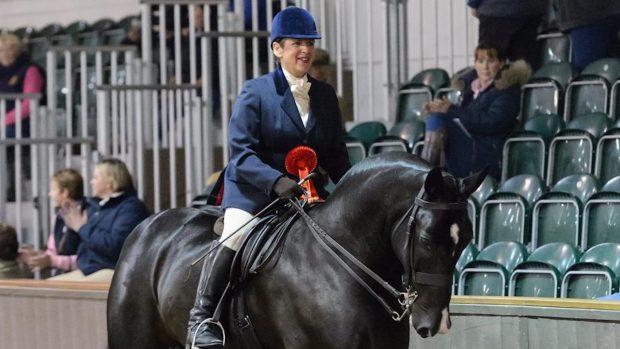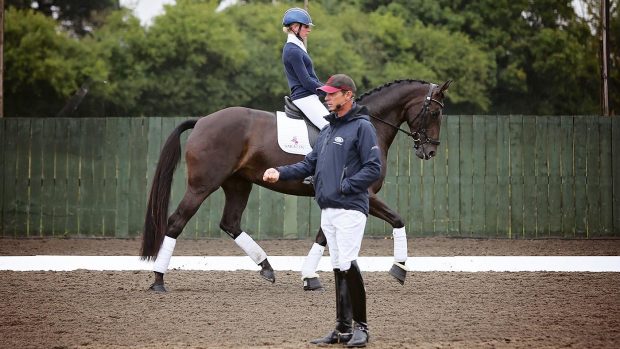In his latest book 'The Cobs Can! Workbook', Omar Rabia looks at progressive training exercises designed specifically for cobs. Here, ridden piaffe is introduced
There seems to have been a huge increase in the number of cobs, natives and heavy horses being given more comprehensive schooling, and appearing in classical equitation as well as competitive dressage classes — which means more ‘everyday’ riders are enjoying schooling their supposedly ‘humble’ mounts to a higher level as a result.
Reaching the pinnacle
Getting to this point is a real achievement. Well done! Piaffe is often seen as the hallmark of classical riding and certainly, by some, as the pinnacle of our sport. For a cob to get to this level is an even greater achievement.
Prerequisites
Piaffe is a prime example of a movement that only becomes possible once the foundations have been laid by correct, progressive work in other areas. The key prerequisites can be summarized as follows:
Cob’s prerequisites
While it is essential that the basics of correct bend and way of going are established, it is not essential to have all the lateral exercises fully developed before beginning work on the ridden piaffe. It can, rather, be started alongside this lateral work. Much of the work towards piaffe is already happening within our transitions from rein-back anyway. Half-steps of piaffe should have become established in-hand as well. What must be remembered, however, is that the piaffe should, and indeed must, be developed slowly over months and years rather than days and weeks.
Rider’s prerequisites
Your posture and position must be close to correct, with an upright pelvis that does not tip to one side or another. You should be able to maintain a steady, correct contact without pulling back or dropping the contact and therefore ‘deserting’ your cob. You should be well versed in the exercises of the rein-back and the correct aiding of that movement.
Sequence of development
As mentioned above, the piaffe work has already been started. The reinback forms the foundation for the piaffe and, coupled with the transitions from rein-back into trot, the main method of bringing about this highly collected trot on the spot is already being consolidated. The key now is gradually, over weeks and months, to shorten the trot out of the rein-back. By doing this slowly, you maintain energy and lively impulsion while making the steps shorter and shorter. This is a long process that should not be rushed.
Think about it as a system of conditioning your cob’s muscles ready to perform a very difficult movement. After some weeks of shortening the trot out of the rein-back, you will need to restrain as much forward impetus as possible out of the rein-back.
Though piaffe must maintain a ‘forward’ feeling, you need to feel as though you have reduced the actual forward step to little more than 15cm per step – some riders indeed feel as though they have asked their cob to remain almost on the spot. This is done with your seat as well as your contact. At the moment of riding forwards out of the reinback, your shoulders should come back to upright, but your lower legs need to stay back slightly, though not as far back as for the rein-back.
As you restrain your cob’s forward movement you will need to urge him to bounce up into a diagonal rhythm. When you feel that first ‘bounce’ of the initial piaffe, stop and reward your cob and release him forward. Do not practise this too much in one session; rather build it up little and often.

The rein-back, and its transitions to trot, are the basis for developing the piaffe
Once he is working in that diagonal movement easily for that initial bounce, ask for a few more steps, increasing just one step at a time. Keep your upper body feeling light and lofty as this will help get your cob up off his shoulders for the piaffe. When your cob is stepping diagonally, maintain that ‘forward’ feeling as mentioned above, but keep the stride ‘closed’ so that each step remains about 15cm in length.
This closed stride, while maintaining the forward attitude, keeps the strides developing towards a piaffe rather than leaking out towards a collected trot.
If your cob finds this ridden progression too difficult, go back to in-hand work and use this as a basis for establishing the ‘bounce’ ridden. Either have someone helping from the ground, or alternatively use the whip in the way your cob recognizes from the in-hand work in your ridden work. Again, build up slowly. One or two good steps are better than many incorrect or rushed ones.
Like this? You might also enjoy reading these:
10 super cobs crowned champions in the show ring this season
29 pictures to prove that cobs CAN do dressage (and excel at it)
In time, you can start to ask for the diagonal steps from a shortened collected walk. To attain collected walk, your seat needs to ‘contain’ the walk a little more: your seat muscles close a little more at each stride to keep the walk steps short. You will feel as though you are rising through your diaphragm (without hollowing your back), using your body to raise your cob’s centre of balance. Your hands maintain a lively bubbly contact, which has shortened a little, with slightly higher hand-carriage, asking gently for a more advanced collected outline.
Your legs must, of course, maintain a lively impulsion despite the steps becoming shorter and shorter.
To move from collected walk into the diagonal steps of piaffe, you simply adopt your piaffe position and aiding, and pulse with your legs until the diagonal steps emerge.
Soon, you should be able to do this from a shoulder-in positioning, as this will not only put your cob into a ‘sitting’ position and lighten his shoulders further, but it will also keep his quarters under control. Again, for each of these steps, reward your cob as soon as you get what you want and remember to practise this on both reins and in different areas in the school.
Soon, transitions from the diagonal half-steps of piaffe to the trot will help give the piaffe energy and keep it bubbling and popping like champagne. Ride two or three steps of piaffe before releasing the energy forward and trotting on.
Again, build up these steps until you can ride four or five before releasing the piaffe forward into the trot.
If your cob gets strong in your hand, go back to the rein-back, walk, rein-back transitions until he softens and his steps become more contained.
If he rushes off in trot out of the rein-back, add some shortened walk steps and build up the diagonal piaffe steps from there. If the initial bouncy piaffe steps peter out, ride every piaffe out into an energetic trot so your cob knows that energy is always a requirement. If his poll is carried low, lift both hands, expecting him to lift his head, and allow the piaffe steps to go a little more forward for a step or two.
Although it is uncommon, some cobs will try to go hollow, in which case repeat your walk, rein-back, walk transitions with a focus on the round, soft outline before asking again for those diagonal steps.
As long as your cob does not show any of the faults mentioned above, you could start at this point to ‘sit’ him more on the spot for two or three steps before allowing the piaffe to cover a little ground again. At this stage, make sure he does not drop his poll or lose energy.
If he does, following the advice given above should help.
Initially, the aiding of the legs will be slightly behind the girth, pulsing and energizing, urging your cob forward. Later on, as he becomes more conversant with the exercise, your lower legs begin to work alternately with the swing from side to side: as his hip drops and his belly swings away, your lower leg pulses and energizes.
Having said that, you should not feel that you are putting lots of effort into the alternating pattern – rather your cob will allow it to happen naturally with the undulations of his body. Of course, he will only do this if he is truly forward and energetic without needing to be worked hard by you.
When you feel as though your cob works himself off alternating legs, you can be sure his piaffe is developing well.
Why you won’t want to miss the H&H Festival of Dressage…
The Horse & Hound Festival of Dressage is a three-day unaffiliated competition featuring championship classes from intro to medium level, as well as warm-up and evening freestyle competitions. It is being held at Sheepgate Equestrian, Lincs on 20-22 July. There will be a prize fund of about £1,000 per level, including winners’ rugs and top-quality prizes. And as well as the dressage, competitors are invited to a drinks reception on the Friday, a hog roast on the Saturday and more evening entertainment, giving all the buzz of a stay-away championship. Find out more >>
The Cobs’ Can! Workbook by Omar Rabia is published by J A Allen, imprint of The Crowood Press (ISBN 978190880930)



